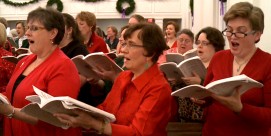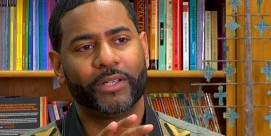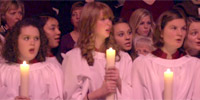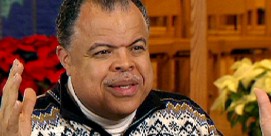In This Episode << SLIDE LEFT TO SEE ADDITIONAL SEGMENTS
William Edwards Extended Interview
Read more of Kim Lawton’s December 6, 2009 interview in New York City with William Edwards, author of The Festival of Nine Lessons and Carols (Rizzoli, 2004):
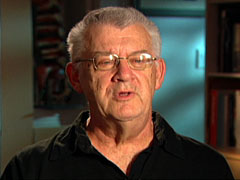 Tell us how this service got started.
Tell us how this service got started.
The service as we know it started in 1918 in King’s College Chapel, and it was started by the chaplain, Eric Milner-White. He had taken a concept that had been used in 1880 in Truro by Ezra Benson, who later became the Archbishop of Canterbury, so it wasn’t a new idea, but he made it what it is today. You have to visualize December 1918 in Cambridge. This is a university where somewhere in the area of half of all of the undergraduates had gone off to war, and a third of them never came back. On December 24, 1918, six weeks after the end of the war that was going to end all wars, you’ve got a congregation which is probably largely made up of widows, girlfriends—in those days they would’ve been called fiancées—children there to somehow deal with this horror that they’d just been through. Most Americans, because we weren’t as deeply involved in the First World War, don’t understand the impact that war had on Europe. I grew up, we all grew up, really, being talked to about appeasement and how we gave Hitler too much and blaming [Prime Minister Neville] Chamberlain, but in fact if you look at what the British had gone through less than twenty years before you can understand. I mean, 900,000 Britons were killed in that war compared with only 300,000 in the Second World War, even with the Blitz and everything else. The war had taken the best and the brightest, and [Eric Milner-White] put together a service of what he called Nine Lessons and Carols, and the nine lessons were things from the Scriptures in, at that point, of course, the King James Bible. There were four from the Old Testament foretelling the birth of Christ, four from the New Testament telling the Nativity story, and one from the Book of John, “In the beginning was the Word,” and so on, and he interspersed them with carols.
What do you think he wanted to do? How would this Christmas service have had an impact on those who had suffered so much?
I think he wanted to deliver some level of comfort, that all this pain and suffering and death had some meaning. There was so much rationalization about the war. We’ve heard the term “the war to end all wars.” They wanted to believe it made sense. We now know from the perspective of the rest of the century that the war proved nothing. It killed millions of people, and it only led to the Second World War, which killed many millions more, and from our perspective it seems insane sending men out of the trenches to be mowed down by machine guns. But, in any case, he also wanted to restore more of a sense of a traditional liturgy in the chapel, and this was relatively High Church Episcopal at the time. He was appointed the chaplain earlier that year, and this was really his first meaningful effort, and it turns out, of course, here we are almost 100 years later, and the service is unchanged from what it was then. The only change he made, and it was a very important change in the service in 1919, he inaugurated the use of “Once in Royal David’s City” as the processional hymn at the beginning of the service, and to most people who think of the service they think of that single boy soprano singing the first verse of “Once in Royal David’s City” as the choir begins to come into the church. Most—not all, but most churches that have picked up in some way the Nine Lessons and Carols use that carol at the beginning of the service.
At King’s College I know they have a special tradition about the boy who sings that.
In the process of doing my book, I interviewed Stephen Cleobury, who has been the director of music there since 1982, and he said that it used to be that they would tell the boy who was going to be the chosen boy a week or two before so he could tell his family, and what happened was the boy, in several cases, got so nervous that he didn’t perform well. And so what they now do is a system where there are three boys, and they say, “It’s going to be one of you,” and then at the very beginning, just before they begin the procession, they tap the one boy on the shoulder and say, “You’re it,” and that boy starts. Now I will say this. The year I was working on the book, and I went over there and interviewed everybody, they had me interview two choristers, and one was this big, husky boy who was obviously a soccer player and just a delightful working-class kid who was in this boy’s choir at school. It was clear that he was expected to be the chosen boy, and indeed he was. I have a feeling that somehow or other, through body language or something, he had picked up the message before the beginning of the service, but he had so much self-confidence it wasn’t going to be an issue for him. But normally there are three boys, and each one does not know if he’s going to be the boy.
Talk about from that first service in 1918, how it was received, and how it kept getting more and more popular, not only in England but around the world.
I don’t know, and there isn’t much documentation as to how—because it was primarily word of mouth how people learned from year to year. But what did happen throughout the early 1920s, more and more people would attend the service, and by 1928 it was well-known enough that the BBC, which was then in its infancy, I mean we’re talking radio 1928, picked it up to broadcast throughout the British Isles, and then two years later throughout the world, so obviously there was a lot of word of mouth. I have not been able to find much of anything in ephemera, magazines, newspapers, anything like that of that period that says “this is a wonderful service, come to it,” but the word got around very quickly so that by the 1930s everybody, and once it was on the radio everybody in Britain knew what it was and, you know, you’ll ask anybody British, and they’ll say, “Well, that’s when Christmas begins.”
What about beyond Britain? How did it spread around the world?
I think you have to start with the BBC World Service, which was broadcasting the service on short-wave starting in the 1930s, and I’ve always loved the idea of people, particularly in the beginning of the war, and we think of December 7, 1941 as when the United States got into the war, but it’s also when the British were first attacked in the Far East. In fact, the fall of Singapore was, to Churchill, one of the great shames of the British efforts in the war. He was outraged that Singapore had fallen. But during December of 1941 Singapore was under siege, and nobody knew what the Japanese could do. The British also, of course, controlled Hong Kong and obviously were closely tied to Australia, and there were a lot of British people there, and nobody knew how big this was going to be, whether ultimately the Japanese were going to take all of the Pacific, and they did of course conquer Singapore, and it must have been a great comfort to turn on the radio and hear this sound of home in December of ’41 and throughout the war. During the war, they took all of the glass out of the—because of the English Reformation, much of the glass from churches that existed before that was lost, but because the chapel was on a university campus, it was protected from the worst outrages of the Reformation, the destruction of the monasteries, and so forth, and the glass is some of the best late medieval glass you can find anywhere, and what they did, they took the glass out of the chapel throughout the war for fear the Germans would bomb Cambridge, and when they went on the radio they would talk about how this was a service being conducted in a church in England, and they didn’t identify it. But of course everybody knew. Presumably the Germans didn’t know or chose to ignore it.
Talk about today and how it’s grown.
It’s grown such that people start lining up four or five days before the service, and it’s kind of fun to see, you know. It’s a tradition. People come every year, and they know, they have friends, and they wait on line. Most of the people—and I was there like on midnight the night before the service, and at that time I imagine there were probably 75 people waiting on line for a service that wasn’t going to start until 3:00 the next afternoon. Fortunately, it wasn’t cold, and it wasn’t raining, but they’re prepared for that too, and they trade off places in line—hold my place in line so I can go get some sleep, whatever.
Are they waiting for tickets or a good seat?
They’re waiting for a good seat. The best seats are behind the choir screen where the choir is, and there’s a relatively limited number of those, and a bunch of them go to VIPs from the university, so only a handful go to the general public. But basically the church fills up, and if you go at 8:00 in the morning you will see hundreds of people on line. They come from all over the British Isles to stand on line, and the service was really almost unknown in this country until Minnesota Public Radio brought it in. I first learned about it in the late ’60s because I had a Fulbright, and I was living in London, and it was part of the atmosphere, but it wasn’t until 1978 that Minnesota Public Radio, under the leadership of Nick Nash, brought the service to the United States, and Minnesota Public Radio is still the producer of the show which now is heard on every public radio station.
You were there in person at King’s College. What was it about the service that touched you so much?
First of all, it’s a little bit like a pilgrimage. You know, you’ve wanted to do this for years and years. I mean, in my case, I had wanted to go see that service in Cambridge for the better part of forty years, so to finally be there and see it was really quite a wonderful experience, and I guess I’ve always been something of an Anglophile. I’ve lived there, and the research for my unfinished PhD thesis was all done there, and my daughter was born there. There is something—even though I am myself a lapsed Congregationalist, there is something about the organized liturgy of the Anglican Church that is very appealing and very friendly and open.
Why, for you, has this become part of Christmas?
Well, for years even before the service came over the air on Minnesota Public Radio I had whatever recordings I could get of the King’s College Choir singing Christmas hymns, and those we played at Christmas at great length because it’s a unique sound, the King’s sound, and anyone who has heard it will see it as just as unique as hearing Pavarotti or Caruso, one of those unique voices. Once the service was in this country, I started going to various local churches to hear how it had been interpreted and performed by, in my case, Protestant churches running the gamut from Episcopalian to Congregational to Methodist to Lutheran, because so many churches in this country have some version of Nine Lessons and Carols, and what Eric Milner White felt and I think everybody at King’s has felt all along is that, yes, you listen for the music, but the important part is the so-called lessons, which are these simple readings from Scripture that are the same every year.
You’re very familiar with the gold standard, the King’s service. What do you make of local churches doing it in different ways?
Well, I may be a traditionalist, but I think it’s wonderful. I think it’s wonderful that a concept that’s almost 100 years old has the power and has been helped by technology, i.e. worldwide radio, to say something to ministers, priests, whatever you will—hey, I can do something with this that’s meaningful in my church. And yes, of course, King’s is unique. I mean, you have got the boy’s choir, you’ve got the men’s undergraduates, so the sound—and you’ve got the building, which is an extraordinary building, but it’s still about the service. It’s still about the combination of music and the Nativity story and how it was predicted in the Old Testament and how it transpired in the New Testament, so I think it’s great.
Tell us about the tradition you and your wife have here.
This will be the sixth year that we do it, and what we do is we invite a bunch of friends, and it’s gotten to be an unwieldy number, but what the heck, it’s Christmas. We’ll have about fifty people show up at our house, and we’ll tell them they have to be there at 9:45 in the morning, and a few days before the service I go to the King’s website, and I download the order of service for this year, and I go to Staples, and I have copies run off so they actually have the program for this year, and then I’ve got either the radio or I’ve got my computer tuned into BBC, and so I play it and we sing along with the people 3,000 miles away, and the service—what’s fascinating to me is that many of our friends are Jewish. They enjoy it just as much. A bunch of my friends don’t believe in anything, and they enjoy it just as much, and everyone prays along with the prayers, which kind of surprised me, but they do. At the end of the service we serve everybody a big lunch, a buffet lunch and lots of North Fork wines. I live on the North Fork of Long Island, and it’s a wonderful way to spend a day where you’d probably otherwise be running out to the Wal-Mart to get something that you forgot to buy that ultimately life will go on if you don’t have. As I said before, in England they say this is the start of Christmas. Well, that’s the way it feels to us.
What does that say about the enduring power of the service?
Well, I think even if we were not in this economic catastrophe we’re in, we’ve lived through a materialistic age which has not yielded most people what they hope they’d gotten. So it’s not surprising that more and more people are going to some version of Nine Lessons and Carols every year. It’s not surprising that over 100,000 people, growing at ten percent every year, are walking the Camino de Santiago in northern Spain every year from all over the world—did it myself this spring. It’s about finding, I think, some kind of spiritual component in life that people are missing. You asked about the relationship of the lessons to the music, and I think anyone who listens to the service from Cambridge, and particularly it’s helpful if you’ve downloaded the program from the King’s website. You’ll see the relationship. Each carol is intended to illustrate the lesson that went before. That’s why in “The Fall of Man,” which is the first lesson, where they have a chorister talk about how Eve got Adam to eat of the apple and wasn’t that a terrible thing, they always follow it with the only carol I know that is related to the apple, and that is “Adam Lay Ybounden” which is a medieval or Renaissance, I guess technically, carol about why Adam took the apple, and blessed be the apple, and so on. But if you listen through the nine lessons, each carol that is sung is illustrative of the lesson that preceded it.
What’s your favorite part of the service?
My favorite is, I think, probably everybody’s favorite, and I can’t even talk about it without getting choked up because it’s so emotional, and that’s hearing those first few bars of “Once in Royal David’s City.” It’s just magic. Magic.

